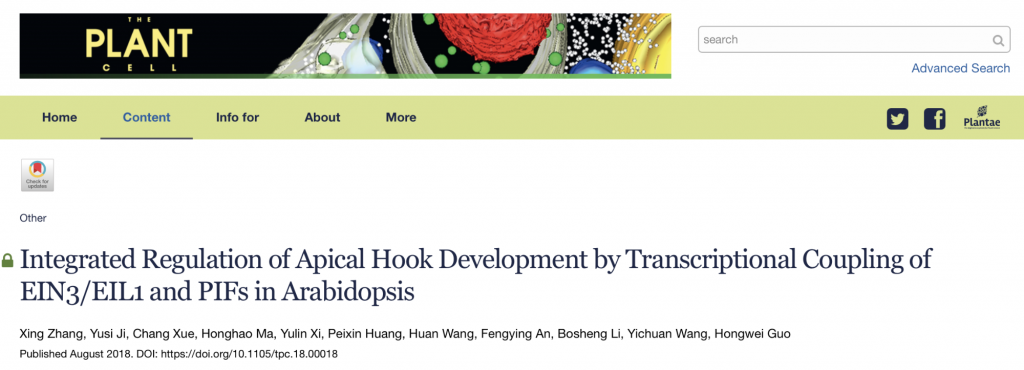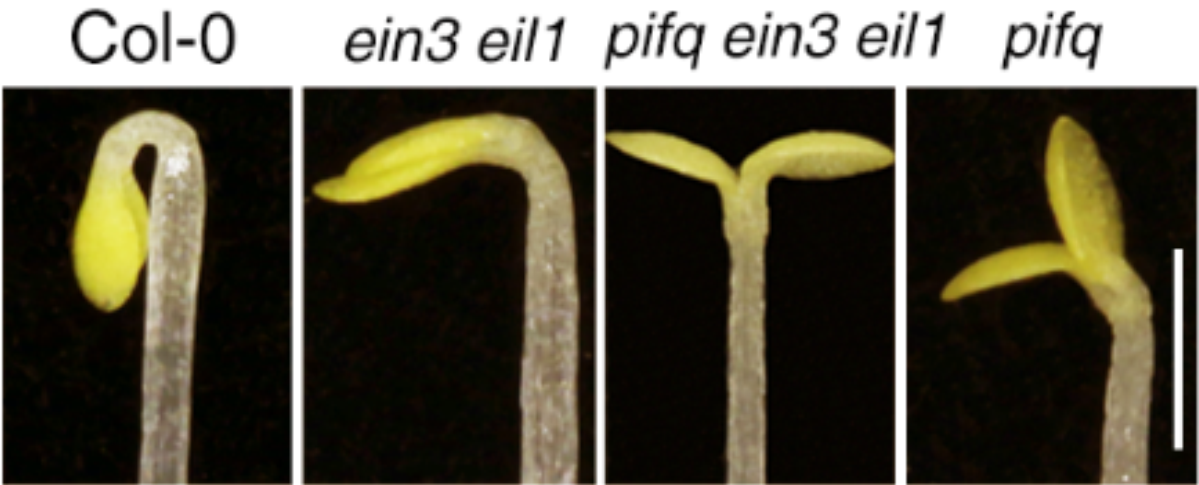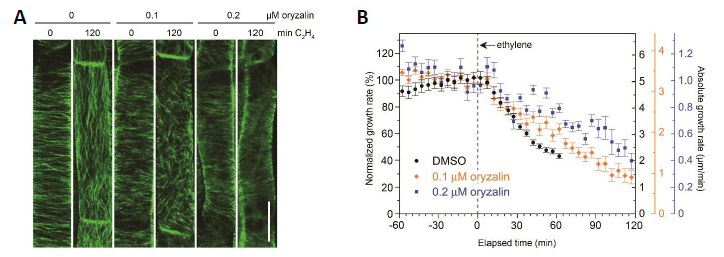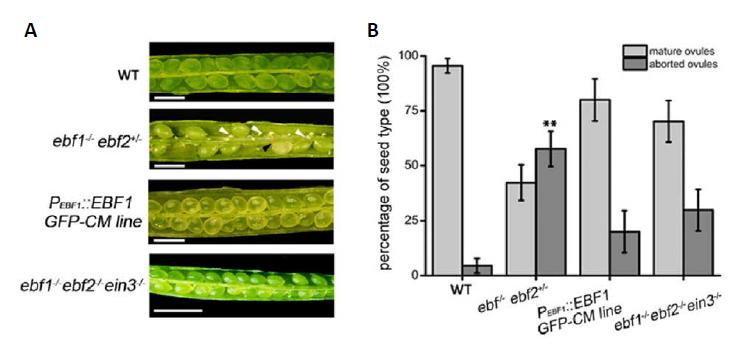On August 13, 2018, Professor Guo Hongwei from Institute of Plant and Food Science (IPFS) at Southern University of Science and Technology (SUSTech) published an online research artical entitled “Integrated Regulation of Apical Hook Development by Transcriptional Coupling of EIN3/EIL1 and PIFs in Arabidopsis”. Dr. Zhang Xing, a visiting scholar at SUSTech (now a postdoctoral fellow at Duke University), is the first author of the paper, and Guo Hongwei is the corresponding author of the paper.

Guo Hongwei is a Chair Professor of Department of Biology at SUSTech, a recipient of the National Science Fund for Distinguished Young Scholars. In 2016, he was appointed as the director of IPFS of SUSTech. He has long been engaged in plant molecular biology and genetics and has deep knowledge in the field of plant hormone biology. He is currently the member of the 11th National Youth Federation Standing Committee, the director of the Youth Working Committee of the Chinese Botanical Society, the executive director of the Chinese Botanical Society and the Chinese Crop Society, and the editorial board of the famous academic journals, such as TPC, Mol Plant, PCP, JIPB, and JGG.
Sessile plants must adapt to the changing environment by adjusting their own forms. The apical meristem is vital in the growth and development of plants and is an important source of cells for the growth of aboveground tissues. In order to avoid mechanical damage during the soil emergence process, the hypocotyls of the dicotyledonous plants are actively bent at the apical part, forming an “apical hook” which directly confronts the upper soil, such that the two cotyledons and the meristems in the middle are protected. Previous studies revealed a positive correlation between hook angles and emergence rate. Therefore, the normal development of apical hook is crucial in the adaptation of the dicot seedlings to the soil environment after germination.
The development of plant apical hooks is regulated by complex signals such as exogenous light and temperature and various endogenous plant hormone signals, but the regulatory mechanism is not clear. In 2012 and 2014, Guo Hongwei’s team found that the core transcription factors of the ethylene signaling pathway, EIN3/EIL1, directly binds to the promoter of HOOKLESS1 (HLS1) gene and activates its transcription to promote the formation of apical hook (An et al. 2012 Cell Research; Zhang et al., 2014 Plant Cell). HLS1 is an important regulator of apical hook formation, and hls1 mutant exhibits a complete hookless phenotype. This study continued the past work and found that PIFs transcription factors are another type of positive regulators in addition to EIN3/EIL1 during apical hook development. PIFs are core proteins that promote the skotomorphogenesis of plants. They are rapidly degraded after plants are exposed to light. PIFs up-regulate HLS1 gene expression and promote apical hook development by recognizing and directly binding to the E-box sequence (CAAATG, which is different from the EIN3/EIL1 binding site) of HLS1 promoter, a process independent of EIN3/EIL1. Meanwhile, EIN3/EIL1 and PIFs respond to upstream signals (phytohormone ethylene, jasminin, gibberellin, and light) in a similar pattern, and the apical hook phenotype disappears after EIN3/EIL1 and PIFs are simultaneously null in pifq ein3 eil1 sextuple mutant, which no longer response to upstream signals in terms of hook phenotype (Fig. 1. A). Therefore, this study revealed an integrated node composed of two transcription factors, EIN3/EIL1 and PIFs, which together mediate upstream signals such as light and hormones and regulated a series of genes, including HLS1, that play important roles in the development of apical hooks (Fig. 1. B). At the same time, the molecular mechanism of the integration of endogenous signals with exogenous signals to regulate plant growth and development has also provided an example for the study of plant signaling networks.


Figure 1. EIN3/EIL1 and PIFs integratively regulate Arabidopsis apical hook development. A. The apical hook phenotype of 3-day-old Arabidopsis thaliana etiolated seedlings with different genetic backgrounds; B. Working mode of EIN3/EIL1 and PIFs as integrating nodes to regulate apical hook formation and other developmental processes. (quoted from Zhang et al. 2018 Plant Cell)
Guo Hongwei’s team has long been committed to the research of plant hormone signaling mechanism, particularly, the gaseous phytohormone ethylene as major research focus. They have revealed several important mechanisms of ethylene signaling and how ethylene interacts with other signaling pathways. In addition to the above work, the Guo Hongwei team recently also published another two important works online in the famous botanical journals Plant Journal and Journal of Integrative Plant Biology. Among them, the Plant Journal work is a cooperation with Professor Yang Zhongnan of Shanghai Normal University (Guo Hongwei is the co-corresponding author), which revealed the molecular mechanism that how ethylene regulates synergid cell degradation during plant fertilization; The work published in the Journal of Integrative Plant Biology revealed the mechanism by which ethylene regulates the microtubule cytoskeleton rearrangement of Arabidopsis primary root via the auxin pathway (Fig. 3) (Guo Hongwei and his team member Dr. Wang Yichuan are co-corresponding authors).


Figure 2. Seed morphology and abortion in ethylene signaling mutants and transgenic restorer lines. A. Seed morphology in siliques of different genetic background materials; B. Seed abortion statistics of different genetic background materials. (quoted from Zhang et al. 2018 Plant Journal)
Through the above research, Guo Hongwei’s team further expanded our understanding that how ethylene integrates with other internal and external factors to regulate the growth and development of plants, and provided new ideas for future agricultural practice to improve important crop traits such as soil emergence, root growth and seed generation. The above researches were funded by the National Natural Science Foundation of China, the start-up funding of SUSTech, and the Peking-Tsinghua Joint Center for Life Sciences.
Plant Cell article full-text link:
http://www.plantcell.org/content/early/2018/08/13/tpc.18.00018
Journal of Integrative Plant Biology article full-text link:
https://onlinelibrary.wiley.com/doi/full/10.1111/jipb.12666
Plant Journal article full-text link:
Proofread ByXia Yingying
Photo ByInstitute of Plant and Food Sciences